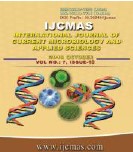


 National Academy of Agricultural Sciences (NAAS)
National Academy of Agricultural Sciences (NAAS)

|
PRINT ISSN : 2319-7692
Online ISSN : 2319-7706 Issues : 12 per year Publisher : Excellent Publishers Email : editorijcmas@gmail.com / submit@ijcmas.com Editor-in-chief: Dr.M.Prakash Index Copernicus ICV 2018: 95.39 NAAS RATING 2020: 5.38 |
Soil enzymes, microbial biomass carbon (MBC), soil microbial population and soil biochemical properties were assessed to understand the influence of different organic inputs on gladiolus under open condition during 2015-16 to 2016-17. The experiment was laid out with 8 treatments in Randomized Block Design and replicated 3 times. The treatments were T1 [RDF(20:20:20g m-2 NPK + 4kg m-2 FYM)], T2 [Rock phosphate + Microbial consortium], T3[T2 + Vermicompost (2.5 t ha-1)], T4 [T2 + Vermicompost (5 t ha-1)], T5 [T2 + Compost (2.5 t ha-1)], T6 [T2 + Compost (5 t ha-1)], T7 [Enriched compost (2.5 t ha-1)] and T8 [Enriched compost (5t ha-1)]. The soil enzymes fluorescein di-acetate (FDA), phosphomonoesterase (PMEase), dehydrogenase (DH), arylesterase (ARE) and arylsulphatase (ARS) involved in energy flow and nutrient cycling showed significant higher activities under different organic inputs. T8 (Enriched compost 5t ha-1) demonstrated clear increase in FDA (8.35 μg fluorescein g-1 soil h-1), PMEase (63.76 μg p-nitrophenol g-1 soil h-1), DH (125.42 μg TPF g-1 soil 24 h-1), ARS (20.79 μg p-nitrophenol g-1 soil h-1), ARE (147.97μg p-nitrophenol g-1 soil h-1), MBC (522.90 μg g-1 soil) and microbial population in gladiolus. Maximum organic carbon (1.12%) accumulation was observed in treatment T8.
 |
 |
 |
 |
 |